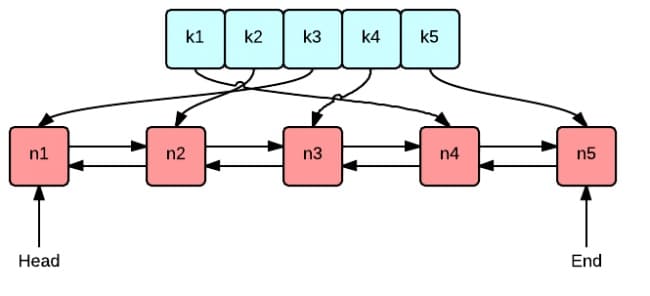Groupcache 介绍
Groupcache 是一个内存级别的分布式缓存,在许多情况下可以替代 memcached 节点池。
和 memcached 比较
相同点
Groupcache 与 memcached 相比,相同点在于:
- 按照 key 进行切分,用于选择哪个节点对该 key 负责。
不同点
不同点在于:
- 不需要运行一组单独的服务器。groupcache 是一个客户端,也是一个服务器。它连接到自己的 peer,形成分布式缓存。
- 带有缓存填充机制。memcached 只是说“缓存丢失”,这通常会导致来自无限数量的客户端连接数据库(或其他)加载缓存。而 groupcache 协调缓存填充,使得整个复制的一组进程中只有一个加载填充缓存(singleflight),然后将加载的值多路传输给所有调用方。
- 不支持变更 values。既没有缓存过期时间,也不能显式的从缓存中删除。
- 支持将热点条目自动镜像到多个进程。对于热点条目,自动镜像到多个节点,这样可以防止单点存储热点数据的服务器过载。
LRU
LRU,Least Recently Used,最近最少使用。如果数据最近被访问过,那么将来被访问的概率也会更高。
LRU 算法的实现非常简单,维护一个队列,如果某条记录被访问了,则移动到队尾,那么队首则是最近最少访问的数据,淘汰该条记录即可。
数据结构
下图就是 LRU 的数据结构:
- 蓝色的是字典,用于保存 key 和 value 的映射关系。
- 红色的是双向链表(作为队列),将所有的值存储在双向链表中。头部代表最近被访问的数据,尾部代表最久未被访问过的数据。
- 当访问到值时将这个元素移动到双向链表的头部。
- 如果需要删除最近最久未被访问的数据,只需要删除尾部元素即可。

LRU Cache
entry 条目
lru.entry 定义了存储在双向链表中的条目,包括键(key)和值(value)。
1 | // A Key may be any value that is comparable. See http://golang.org/ref/spec#Comparison_operators |
Cache 结构体
lru.Cache 是一个 LRU 缓存,其中:
- MaxEntries 定义了缓存中最大的数据量。
- ll 为双向链表。
- cache 为键和值的映射。
- OnEvicted 定义了当这个键从缓存中移除时,需要进行的操作。
1 | // Cache is an LRU cache. It is not safe for concurrent access. |
同时 lru.Cache 还定义了一些对于缓存的操作:
添加键值对:
- 这里用了懒惰初始化的方法,当真正需要添加数据时才对双向链表和字典映射做初始化。
- 当看key 对应的数据存在时,将元素移动到链表头部,然后改变 value。
- 不存在时新建一个元素,将元素移动到链表头部。
- 当超过缓存数据量限制时,删除最老的缓存数据。
1
2
3
4
5
6
7
8
9
10
11
12
13
14
15
16func (c *Cache) Add(key Key, value interface{}) {
if c.cache == nil {
c.cache = make(map[interface{}]*list.Element)
c.ll = list.New()
}
if ee, ok := c.cache[key]; ok {
c.ll.MoveToFront(ee)
ee.Value.(*entry).value = value
return
}
ele := c.ll.PushFront(&entry{key, value})
c.cache[key] = ele
if c.MaxEntries != 0 && c.ll.Len() > c.MaxEntries {
c.RemoveOldest()
}
}查询键所对应的数值:
1
func (c *Cache) Get(key Key) (value interface{}, ok bool)
键值删除:在删除时会调用 OnEvicted 所定义的函数。
1
func (c *Cache) Remove(key Key)
获取缓存当前大小:
1
func (c *Cache) Len() int
清空缓存:
1
func (c *Cache) Clear()
ByteView
ByteView 保证的内部字节的不可变(这是 groupcache 的特性,不可更改 value)。
ByteView 结构体
ByteView 在内部封装着一个字节切片和其对应的字符串,但是调用者看不见这个内部细节。
1 | // A ByteView holds an immutable view of bytes. |
ByteView 方法
ByteView 定义了很多方法,并且还实现了 io.ReaderAt 和 io.WriterTo 接口:
查询 ByteView 的长度:
1
func (v ByteView) Len() int
获取一个字节切片的复制:
1
func (v ByteView) ByteSlice() []byte
获取字节切片对应的字符串:
1
func (v ByteView) String() string
获取字节切片中下标为 i 的字节:
1
func (v ByteView) At(i int) byte
获取
[from, to)范围内的字节:1
func (v ByteView) Slice(from, to int) ByteView
获取
[from, end)范围内的字节:1
func (v ByteView) SliceFrom(from int) ByteView
将字节切片复制到指定的切片中,返回被复制的字节数:
1
func (v ByteView) Copy(dest []byte) int
用于比较的方法:
1
2
3
4
5func (v ByteView) Equal(b2 ByteView) bool
func (v ByteView) EqualString(s string) bool
func (v ByteView) EqualBytes(b2 []byte) bool返回一个 io.ReadSeeker:
1
2
3
4
5
6
7// Reader returns an io.ReadSeeker for the bytes in v.
func (v ByteView) Reader() io.ReadSeeker {
if v.b != nil {
return bytes.NewReader(v.b)
}
return strings.NewReader(v.s)
}
实现 io.ReaderAt 和 io.WriterTo 接口:
2
3
4
5
6
7
8
9
10
11
12
13
14
15
16
17
18
19
20
21
22
23
24
25
26
27
28
29
func (v ByteView) ReadAt(p []byte, off int64) (n int, err error) {
if off < 0 {
return 0, errors.New("view: invalid offset")
}
if off >= int64(v.Len()) {
return 0, io.EOF
}
n = v.SliceFrom(int(off)).Copy(p)
if n < len(p) {
err = io.EOF
}
return
}
// WriteTo implements io.WriterTo on the bytes in v.
func (v ByteView) WriteTo(w io.Writer) (n int64, err error) {
var m int
if v.b != nil {
m, err = w.Write(v.b)
} else {
m, err = io.WriteString(w, v.s)
}
if err == nil && m < v.Len() {
err = io.ErrShortWrite
}
n = int64(m)
return
}